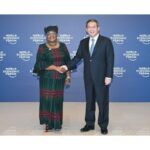
By MIKHAELA EMY SALLE
Bulatlat.com
MANILA – Media organizations, artists, and campus journalists gathered to commemorate the second National Press Freedom Day last August 30.
“This day today is devoted to also looking into the situation of media workers, of cultural workers, and the public in general… ano ang mga nangyayaring (what are the) attacks against freedom of expression and against freedom of the press,” said Lisa Ito, secretary general of the Concerned Artist of the Philippines (CAP), who opened the program.
The day-long event included art exhibits featuring 25 artworks, including one by visual artist Max Santiago who was recently charged over the burning of an effigy of Ferdinand Marcos Jr. in the last State of the Nation Address protest.
A short tribute to the late Luis Teodoro, considered a ‘pillar of Philippine journalism’ was also held. He served as dean of the University of the Philippines College of Mass Communication (UP CMC) and the founding chairperson of Altermidya – Alternative People’s Media Network, an umbrella organization of all alternative news outfits in the country.

Films depicting the struggles of artists and journalists were also screened in the afternoon. Among them were: Velvet Revolution by the International Association of Women in Radio and Television, and Portraits of Mosquito Press by JL Burgos.
How arts raise political consciousness
Cartoonist Zach, whose work was also featured in the event, said editorial cartoons should be given more value and should not be treated as mere decoration for newspapers.
“One cannot deny the role of cartoons and art in raising the political consciousness of people,” he said.
Among the artworks featured were depictions of the impacts of the country’s terror law on the freedom of speech and of the press, and the rampant misinformation where visual artist Jef Carnay depicted the truth as knives that can cut its spread.
There were also artworks calling for the release of detained community journalist Frenchie Mae Cumpio.
Read: ‘Charges vs. effigy artist, an attack against free expression’ – artists, progressives
Cartoonist Zach also criticized the use of lawfare to silence artists, including the filing of charges against Santiago, which the police attempted to feign as violations of environmental laws.
Increasing attacks against journos
National Union of Journalists of the Philippines (NUJP) Chairperson Jonathan de Santos said there have been 94 attacks against journalists under the Marcos Jr. administration.
These include the continuing harassment of three reporters from San Juanico TV who covered a land dispute in Leyte, and the fact that the murderer of journalist Percy Lapid remains scot free.
“Although there are attempts to direct the narrative, to control the narrative, the power still rests on us. We should continue to raise and amplify our voices,” De Santos said.

Among those who also shared their respective experiences include Marc Abila, editor-in-chief of Pinoy Weekly, whose website remains blocked due to an order of the Philippine government. “This is not just an attack against press freedom but also of the people’s right to information.”
He added that Pinoy Media Center, publisher of Pinoy Weekly, is set to file a case this September against the blocking memorandum.
Meanwhile, John Avengoza, chairperson of the Union of Journalists of the Philippines of UP Diliman (UJP-UP) shared that they, too, are being harassed for their critical reportage.
“As campus journalists, we often ask ourselves if we are still safe,” he said.
Film showing featuring the power of the press
In the afternoon, several short and full-length documentaries on the struggles of the Philippine press were shown.
“Cameras played a big role in freeing detained activists during martial law,” veteran photojournalist Lito Ocampo said, adding that taking photos and videos is part of truth telling.
Ocampo, who was among those featured in the series SINGKWENTO: 50 Kwento ng Martial Law, was arrested and tortured for more than five years under the martial law of Ferdinand Marcos Sr.
Read: Through their lenses: Documenting the people’s struggle since martial law
Velvet Revolution, a film on women journalists from different parts of the world, was also screened.
“The camera that you hold is a powerful tool when you use it for the people,” said Ilang-Ilang Quijano, one of the six women filmmakers of Velvet Revolution.
The last film was the Portraits of Mosquito Press by JL Burgos, which narrated the story of their family during the martial law period of Marcos Sr.
Burgos is currently working on the sequel of the said documentary. This time he is focusing on the enforced disappearance of his brother Jonas Burgos. “If we will not call for justice and hold them to account, human rights violators will win. That will be the end of it. The fight would have ended and we will fail.”
Floyd Tiogangco of artist group Dakila highlighted how the Philippines experienced misinformation, intimidation, threats, and even killings towards the people’s media, and how it made the country a dangerous place for journalists.
“Still, our society’s watchdogs persist in delivering the truth… we believe that the fight for press freedom is the fight for the very foundation of our democracy,” he said. (JJE, RTS, RVO) ![]()




